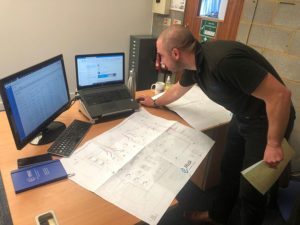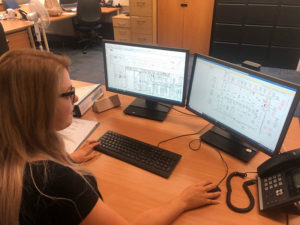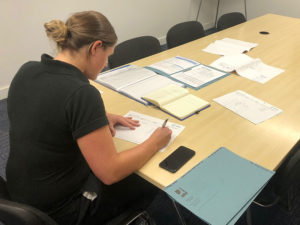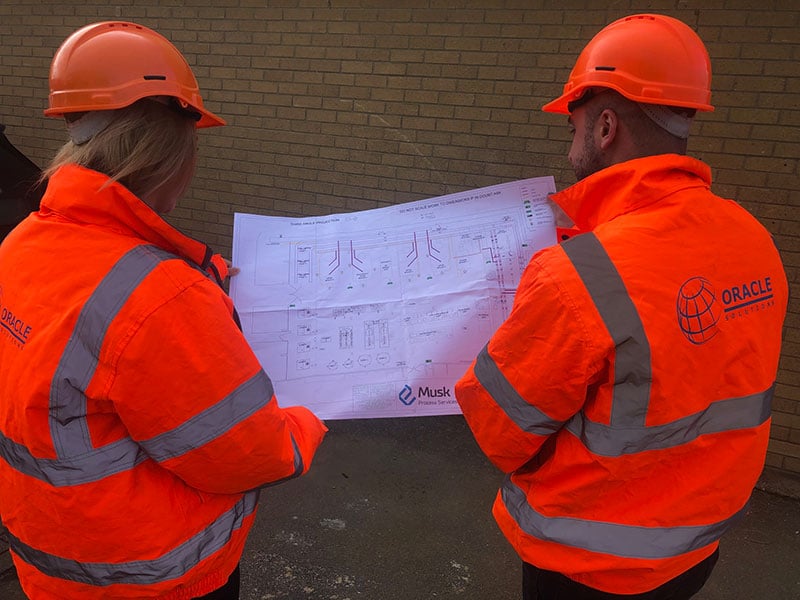What is an asbestos pre-purchase, due diligence, feasibility investment survey?
If you are an investor or joint investor, asbestos within buildings can pose a significant financial risk. Part of your due diligence prior to investing will always be to calculate the return on investment. Many investors fail to accurately consider the potential risk they may be taking when it comes to asbestos within a building or property they plan to purchase.
You may be aware that asbestos is a potential, and you may even be lucky enough to have some asbestos information from the seller. But how sure are you that the asbestos information you have is accurate, up to date, or even covering the complete building or property you’re going to be investing in?
An asbestos survey giving detailed information about the financial risk prior to investing can be called various names, such as:
- A Pre-Purchase Asbestos Survey
- An Asbestos Investment Feasibility Survey
- An Asbestos Risk & Liability Survey
- An Investment Asbestos Due Diligence Survey
Although these types of surveys are known by different names, any asbestos survey carried out before an investment aims to accurately determine the financial risk regarding the potential presence of asbestos within a property. This needs to be carried out before you agree to a purchase price and complete the purchase.
What buildings have a financial investment risk with asbestos and why?
Any building or structure refurbished or constructed prior to the year 2000 is likely to have asbestos-containing materials. The condition, quantity, and location of these asbestos-containing materials can dramatically affect any financial investment being considered for a property.
As an investor, before you purchase a building, it is important that you are fully aware of the financial risk that asbestos may pose. You must have the right information to ensure your purchase’s feasibility, taking into consideration your investment fund. You must be aware of your financial liability should you invest and purchase the property.
If the seller has asbestos information, why will this not be enough?
As an investor, it is important to know that although managing asbestos and record keeping is the law, this has not always been the case. For many properties, asbestos management and record-keeping have not been undertaken correctly.
If you rely on the asbestos information given to you by the seller, you will be risking your investment and putting together your investment feasibility study based on information that the seller has obtained from a third party.
An asbestos service provider will have put together all records they have for the current owner or even a historical owner/tenant. There is no way for you to guarantee, or even check, the competency of those who have collated the asbestos information. Therefore, you have no way of knowing if the asbestos information is accurate. Suppose you rely on asbestos information presented to you at the pre-purchase stage. In that case, you will be basing your investment and financial risk, and liability regarding asbestos on information that you cannot guarantee is accurate.
In addition, many buildings have a history of refurbishment and asbestos removal spanning in some cases over decades. Asbestos removal techniques have dramatically changed over the years, and the quality has gradually improved to what it is today. It is a fact that most buildings where asbestos removal or asbestos work has been carried out contain areas of very hard to find damaged asbestos, including asbestos debris from previous asbestos projects. Repairing and making good such areas where asbestos has been poorly removed, costs investors more than it would if the original asbestos-containing materials remained.
In most cases, current information given to you by a seller will also be by way of a simple asbestos management survey. This is not an intrusive survey and would be very unlikely to identify all asbestos-containing materials within a building.
As part of your long-term investment in the building, you will undoubtedly be looking at undertaking refurbishment or improvement works. When this happens by law, you will be required to have a more intrusive asbestos survey carried out, which will involve intrusive inspection techniques. All those areas of asbestos that you did not know about will now be very expensive and an unforeseen drain on your investment capital.
Also, even if you are not looking to carry out refurbishment works, you will be required by law to safely manage the risk from asbestos at the site once you become the owner. This includes making safe all asbestos materials and removing those that cannot be made safe. Are you fully aware of the cost of even the most basic asbestos management for that property?
I have not purchased yet, so cannot cause damage; how can you accurately assess the real investment risk from asbestos?
Pre-purchase and investment sellers will not want you to be intrusive to the property and they will not want you to cause damage. This is why at this stage, the usual asbestos surveys are not fit for purpose. This is where an asbestos pre-purchase, due diligence, and investment survey is the only way to fully detail your asbestos risk and liability.
The pre-purchase survey does not require intrusive inspections. The following explains the survey’s whole process and how the information is gathered to ensure you have accurate asbestos risk for your potential investment before you buy.
Item 1: Choosing the Team
Choosing the team to undertake your pre-purchase survey and feasibility study is the first and most important step. The team must be asbestos professionals with qualifications in both asbestos surveying and asbestos removal to carry out this type of survey.
The team must have relevant experience in locating and identifying asbestos materials. They must also have extensive experience in the usage of asbestos within certain construction types to accurately predict where asbestos would have most likely been used, given the nature of the property in question.
The team must have the experience to be able to understand asbestos remediation and removal techniques. It is also useful for the team to be competent in risk assessing additional site factors such as lead in paint and anthrax etc. They must be able to accurately provide costings on every type of asbestos material, extent, condition, and location, providing accurate financial budgets with time scales for every potential asbestos-related removal/remediation.
At Oracle, we have a bespoke team for these types of surveys. Everyone chosen for this type of investment survey has a minimum of 15 years of extensive experience in asbestos removal and surveying.
Item 2: Asbestos Information Study

Once the quality and potential accuracy of the asbestos information has been measured, the asbestos information will then be transferred into a useable format ready for the pre-purchase survey’s next steps. This is to ensure ease of cross-referencing throughout the process of the pre-purchase and due diligence survey.
Item 3: Building Information Study

Initial historical investigations into the building, its construction date, construction type etc.
A full historical timeline of construction, additions, refurbishments, and general improvements through the local authorities planning and consent department (including land registry information).
Undertake request of information from the Local Enforcing Authority HSE on historical asbestos-related incidents and ASB5 asbestos works notifications. This request is made under the Environmental Information Regulations 2004.
Contact and talk with previous owners, historical owners/tenants for the purposes of collating any relevant information regarding the use of asbestos or asbestos removal.
Contact local town or city councils for historical information on regeneration schemes or similar that may have had an impact on asbestos and its use or removal within the building.
All this information is added to the historical asbestos information previously collated. All data is now in a useable and easy to access format, ready for step 4 of the asbestos pre-purchase, due diligence and investment survey.
Item 4: The Site Visit
Step 4 is a detailed site visit. Armed with all of the information gathered so far, the team visits the site to inspect all accessible areas visually. There are no intrusive works, no sample taking and no disturbance to current occupiers, if any.
The site visit is undertaken on behalf of you, the investor, and is advertised to those who may need to know as part of the due diligence and feasibility required before purchase. As such, there is generally no challenge in obtaining access for this purpose. Site visits are undertaken discreetly with the asbestos basis kept to a need to know basis.
Each area is inspected with detailed observations on construction and general condition. The team then evaluates the potential asbestos present within each area using gathered information to support their observations. The team photograph as many observations as possible throughout the site visit so that the investor can review it within the final report. This is where the experience of the team for pre purchase asbestos risk assessment is vital.
The observations include looking for evidence of historical poor asbestos removal projects and general construction materials throughout. In addition to asbestos, the team should also note any other stand out risks that may be of value to the investor. Items such as lead in paint and legionella are generally recorded where potential risk exists.
Item 5: The Cost Analysis

Item 6: The Final Report
Items 1 through to 5 have now gathered all relevant and useful information regarding any asbestos and its potential financial risk for an investor. The final report is then prepared to present this information in a user-friendly format for the investor. The report contains the following detailed sections:
- Introduction – The purpose of the report
- Historical Information, Construction and
- Refurbishment Details
- Asbestos Historical Information
- Historical Asbestos Usage – Known and Potential
- Site-Based Observations
- Summary of Proven and Potential Asbestos Presence
- Asbestos Remediation During Any Development
- Asbestos Remediation for Management
- Asbestos Costs and Time Scales for Development and/or Management
- Additional Risk Observations
- Appendices for Photographs, Plans etc.
How will the asbestos pre-purchase report help me before I invest?
The report gives a complete picture of the potential financial risk prior to purchasing. The financial risk is divided into three main elements that enable the investor to make an informed decision on the potential investment. The three main financial risk categories are:
1. BEST CASE – The minimum financial risk.
This is based on everything being on the investor’s side, and no additional asbestos other than that easily observed being found for the purposes of asbestos management and or development of the property.
2. LIKELY – The most likely financial risk.
This is based on the team’s expert opinion and considers all information, including the site visit. The experience of the team is key. Oracle has a proven track record with all pre purchase asbestos surveys “likely” financial risk observations being within 2% over a 12-year period of the actual expended as part of the development or management at the property.
3. WORST CASE – The highest financial risk.
This is based on the absolute worst-case scenario where every potential asbestos-containing material is then identified and requires removal as part of the property’s development. Many investors base their investment on this figure or negotiate a better purchase price based on the potential.
How can Oracle help me with an asbestos pre-purchase, due diligence, investment survey?
Oracle provides a full bespoke asbestos pre-purchase, due diligence and investment survey service throughout the UK. We have a highly experienced team of multi-skilled high-level asbestos professionals. We will give you a complete risk analysis for your financial planning before you invest. Call a member of the team now for more details.
Oracle also provides the following:

